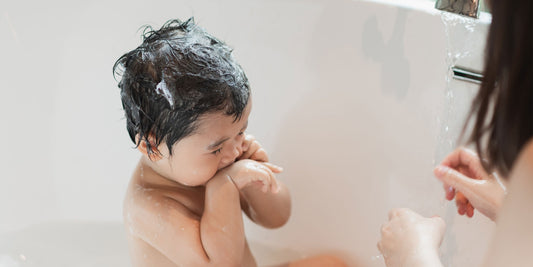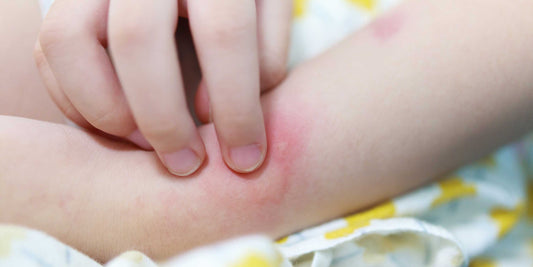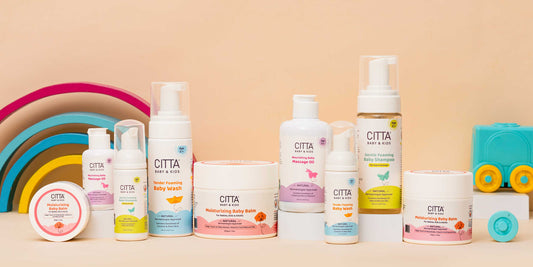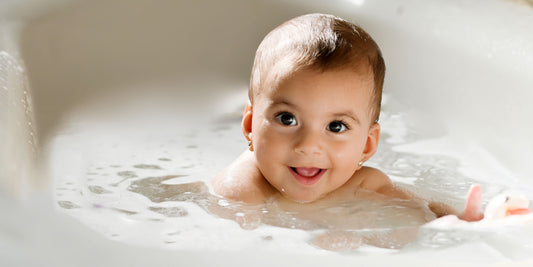Blogs

How to Choose the Right Dandruff Shampoo for Yo...
Do you often find yourself bewildered when choosing the right dandruff shampoo for your little one? Well, you’re not alone! In fact, one of the most common concerns among parents...
How to Choose the Right Dandruff Shampoo for Your Infant’s Sensitive Scalp
Do you often find yourself bewildered when choosing the right dandruff shampoo for your little one? Well, you’re not alone! In fact, one of the most common concerns among parents is dealing with pesky dandruff. Since a baby’s scalp is more sensitive than that of an adult’s, you’ve to be a little picky while selecting an infant dandruff shampoo for them. Thinking about how to go about that? Well, finding the right infant dandruff shampoo need not be intimidating. All you have to do is look for shampoos that are both gentle and effective for your baby’s specific needs. To help you with this, we’ll cover the root cause of dandruff in infants, key ingredients to look for in anti-dandruff shampoos for newborns, and tips that will keep your baby’s scalp dandruff-free and most importantly, healthy. Understanding Infant DandruffHave you noticed scaly, crusty patches on your baby’s scalp? Now, that is cradle cap - a type of infantile seborrheic dermatitis (ISD), with which infant dandruff is often associated. Albeit it looks alarming, cradle cap is generally harmless and often clears up on its own. The causes of it include factors such as overactive sebaceous glands producing excess oil, hormonal changes, exposure to yeast (malassezia), and skin sensitivities. Cradle cap doesn’t always need medicated treatment. That said, in cases where it’s persistent or causing discomfort to the little one, using a mild infant dandruff shampoo can help. As newborns have 20X more delicate and sensitive skin than adults, it is imperative to choose the right products. Features to Look for in Infant Dandruff ShampoosWhen scouring through the multitude of options available in the market, make sure to look for the following qualities in an anti-dandruff shampoo for newborns: Tear-Free & Gentle Formulation: No parent would want a bath time filled with tears. However, baby shampoos containing harmful chemicals and toxins like parabens, phthalates, and sulphates can cause stinging sensations in the little ones’ eyes. Look for formulations that are specifically labeled as ‘gentle’ and ‘tear-free’ to make bath time a breeze. Skin-Friendly pH: The best shampoo for newborns will have a skin-friendly pH as a baby’s skin has a more neutral pH compared to adults. A pH-balanced shampoo helps maintain the scalp’s natural barrier and match the natural acidity of a baby’s skin. Hypoallergenic & Natural Ingredients: Natural ingredients such as oat kernel flour, coconut oil, almond oil, and olive oil are known for their soothing properties and are less likely to cause allergic reactions. Always go for hypoallergenic products with these mild ingredients in order to avoid skin irritation and sensitivities. Dermatologist Tested & Approved: Dermatologist-tested & approved products provide an added assurance that the shampoo is both safe and efficacious for your little one’s scalp. Tips for Healthy Scalp CareAlong with selecting the best shampoo for newborns, it is also important to maintain healthy scalp care routines. Here’s how you can do that: Regular Brushing: Use a soft-bristled bamboo brush or neem comb to gently brush your little one’s scalp. This will help improve blood circulation on the scalp and loosen pesky flakes. Avoid Overwashing: Keeping the scalp clean is important but over-shampooing it is a big NO. Overwashing your little one’s head can strip off its natural oils while aggravating flakiness and dryness. It is ideal to wash your baby’s hair twice or thrice a week with a gentle infant dandruff shampoo. How Often Should You Use Dandruff Shampoo for Your Baby? To put it plainly, it depends on the severity of the condition. The frequency of using anti-dandruff shampoo for newborns is different for babies with mild to moderate dandruff than those with severe dandruff situations. If your little one is experiencing mild to moderate dandruff, shampooing once or twice a week is enough. In severe cases, start by applying a gentle infant dandruff shampoo daily while reducing the frequency as symptoms improve. If the condition persists, make sure to consult with your pediatrician. Tips for Using Dandruff Shampoo on Infants Many times, even after using the best infant dandruff shampoo, dandruff refuses to go away. It could be for a number of reasons. Here’s how to make sure you’re getting the best results when using infant dandruff shampoo: Start with Wet Hair: Before applying shampoo, use lukewarm water to thoroughly wet your baby’s scalp. Not only will this ensure the product spreads evenly, but it will also penetrate the scalp more effectively. Massage Gently: Gently massage an appropriate amount of infant dandruff shampoo into your little one’s scalp. Make sure to use your fingertips and not nails as it can irritate their delicate skin. Rinse Thoroughly: Rinsing out all traces of the shampoo prevents residue from getting stuck into the skin, which can dry it out. So, use lukewarm water to cleanse the scalp thoroughly. Pat the Scalp Dry: After cleansing the scalp, pat dry using a soft and absorbent towel and be cautious to not rub. Rubbing can cause friction and strip away moisture, potentially worsening the condition. Final Thoughts Wrapping up, by adopting a mindful approach, understanding the ingredients and features, and finding out your baby’s specific needs, you’ll be able to select the right infant dandruff shampoo. Look for shampoos with gentle yet effective ingredients that are hypoallergenic and have a skin-friendly pH level. If dandruff persists and you notice additional symptoms like redness, inflammation or swelling, make sure to consult a pediatrician. Hope this guide helps you in ensuring your little one’s scalp stays healthy and happy!
Read More
Benefits of Natural Moisturizers for Newborns t...
As our CEO, Akanksha Sharma, rightly puts it, “The right moisturizer for your little one’s skin can make all the difference!”We couldn’t agree more with her statement! When it comes...
Benefits of Natural Moisturizers for Newborns to Keep the Baby’s Skin Nourished
As our CEO, Akanksha Sharma, rightly puts it, “The right moisturizer for your little one’s skin can make all the difference!”We couldn’t agree more with her statement! When it comes to moisturization and hydration, your little one’s skin needs some extra TLC. Known for their natural ingredients, gently formulated moisturizers offer a slew of benefits for baby’s skin. You must be wondering how a natural moisturizer can benefit your baby’s delicate skin. Here’s a detailed breakdown of why investing in a high-quality natural moisturizer for newborns is the ideal thing to do for keeping your baby’s skin nourished and healthy. Keep reading to know! Benefits of Moisturizers for Newborn Infused with the goodness of shea butter and natural oils, CITTA’s moisturizing baby balm is thoughtfully crafted to cater to your baby’s sensitive skin needs. Unlike conventional water-based creams, CITTA’s moisturizing baby balm contains natural ingredients that are safe and gentle on the baby’s skin while effectively nourishing it from within. Here are its benefits: Long-Lasting Moisturization: With shea butter’s magic and the goodness of eight natural oils, CITTA’s moisturizing baby balm locks in moisture and keeps delicate baby skin deeply hydrated and nourished. And this is why it is one of the preferred choices in many newborn moisturizing balms. What’s In The Tub: At CITTA, we have handpicked the right ingredients and bottled them up for your little one’s delicate skin. Shea butter, almond oil, olive oil, and coconut oil are known for their soothing and moisturizing properties. All these potent ingredients work together to provide significant moisturization and combat dryness. Protection Against Environmental Stressors: The little ones’ skin is 20X thinner and more sensitive than that of adults, making it more susceptible to environmental stressors. Balm moisturizers with natural ingredients help enhance the skin’s barrier. Besides, the inclusion of natural emollients also helps keep skin issues at bay. Anti-Inflammatory: Most natural ingredients are rich in antioxidants, which offer anti-inflammatory benefits while reducing redness and irritation. Besides, they also help protect delicate skin against damage caused by free radicals. Free from Harmful Chemicals: The Safety Advantage Unlike conventional baby creams and moisturizers, a natural moisturizer for newborns is free of harmful chemicals and toxins like sulphates, parabens, and phthalates. These harmful toxins can cause allergic reactions and irritate sensitive skin. Harmful additives like artificial colors and preservatives could potentially cause adverse reactions to the baby’s skin. Gently formulated, natural products minimize the risk of irritation and other skin conditions. Real Parent Reviews: Why They Prefer Our Moisturizing Baby Balm Did you know, over 5000 parents swear by our natural moisturizing baby balm? Here’s why they love it: Intense Moisturization: The rich formulation of our newborn moisturizing balm intensely nourishes and moisturizes delicate baby skin. Parents appreciate the balm moisturizer’s long-lasting moisturizing properties and how it combats dryness without feeling heavy on the skin. Gentle on Sensitive Skin: Parents who have used our natural moisturizing baby balm have reported that our balm moisturizer is less likely to cause allergic reactions or skin irritation compared to conventional baby creams. Babies with extremely sensitive skin or eczema have largely benefitted as reported by their parents. 100% Transparency: Parents appreciate the transparency of our products as we provide detailed ingredient lists on the labels. Besides, the fact that our products are made with natural ingredients, gives parents assurance of their safety and efficacy. Avoiding Common Allergens: Effects on Sensitive Skin Formulated with the goodness of natural ingredients, our newborn moisturizing balm is thoughtfully curated to avoid common allergens. Newborn skin is extremely sensitive and susceptible to external stimuli, and this balm moisturizer protects the skin by restoring and replenishing its barrier. Hypoallergenic Formulations: With its hypoallergenic formulation, our newborn moisturizing balm is great for sensitive skin as it is less likely to cause allergic reactions. That said, different skin types may react differently to natural products. Conduct a patch test by applying a small quantity to your baby’s elbow. Reduced Allergen Exposure: Natural ingredients like olive oil, shea butter, and almond oil, to name a few, are well-absorbed by babies’ skin. Traditionally, these ingredients were used by our dadis & nanis in their purest forms to soothe irritated skin. Keeping those nuskhes in mind, we have used natural ingredients and avoided the use of synthetic additives to minimize the risk of allergic reactions. Steps for Baby’s Skincare Routine A natural moisturizer for newborns is an important addition to your baby’s skincare routine. Incorporating it need not be overwhelming, as all you have to do is follow this simple guide to establish a consistent routine: Choose the Right Product: Get your hands on a balm moisturizer with natural ingredients like shea butter, olive oil, almond oil, and coconut oil. Ensure to check the label thoroughly to check for ingredients and its suitability for newborns. Bathing: During bath time, make sure to use a mild and natural baby wash that helps combat post-bath dryness. Avoid overwashing your little one, as this can strip the skin of natural oils. Moisturize: Post bath, gently pat your little one’s skin dry and make sure to not rub. Follow up with an appropriate layer of newborn moisturizer, paying attention to areas prone to dryness, like the cheeks, knees, and elbows. Daily Application: For ongoing hydration, apply a light layer of moisturizer in the morning and evening, or as needed throughout the day. To Wrap Up Choosing a natural moisturizer for newborns doesn’t have to be very intimidating for new parents. With this guide, you will be able to pick the best for your newborn’s delicate skin. Make sure to look at the list of ingredients before making a purchase, and check if it is free of harmful chemicals and toxins. For additional information on selecting the best moisturizer for newborns or to explore options like balm moisturizers, consult with pediatric dermatologists.
Read More
How Parents Can Find the Best Newborn Eczema Mo...
There are plenty of things no one will tell you before you have kids - things you only figure out after you become a parent. For instance; eczema in newborns...
How Parents Can Find the Best Newborn Eczema Moisturizer to Soothe Skin Issue
There are plenty of things no one will tell you before you have kids - things you only figure out after you become a parent. For instance; eczema in newborns is a common skin issue that most parents face. Characterized by itching, dry patches, and redness, eczema can be both troublesome and frustrating. Besides, getting your hands on the right newborn eczema moisturizer is imperative for soothing your precious one’s highly sensitive skin and preventing flare-ups. Fret not, this guide delves deeper into understanding eczema, its signs and symptoms, and how to select the best balm moisturizer for your little one’s delicate skin. Without further ado, let’s get started: Understanding Eczema and Its Causes Scientifically referred to as atopic dermatitis, eczema is a skin condition that appears on the scalp, face, and body folds. It is often indicated by itchy, inflamed, and flaky skin. Now the question is, what causes eczema? Albeit the exact cause remains unknown, environmental factors, weakened skin barrier, and genetics are major contributors. Since a baby’s skin is 20 times thinner and more sensitive than that of an adult’s, it is susceptible to environmental stressors. Additionally, a compromised or weakened skin barrier can lose moisture quickly, which in turn, leads to flare-ups. All About Eczema in Infants About 10-20% of infants get affected by eczema at some point, and while some outgrow it, others may have recurring episodes into childhood. Reason being? Their delicate and developing skin! And how to manage it? Managing eczema involves an amalgamation of gentle skincare routines and selecting the best newborn eczema moisturizer that hydrates and protects the skin while minimizing irritation. Symptoms Such as Redness, Itchiness, and Dryness in Babies Eczema in babies includes the most common signs like redness, flaky skin, and itchiness. Let’s explore these signs in more detail: Redness: Red, inflamed patches that often appear on the forehead, cheeks, and around the ears. Dry & Flaky Skin: Skin starts appearing scaly and rough, especially during flare-ups. Itchiness: Since the skin becomes itchy, babies tend to scratch or rub the affected areas, which in turn, worsens the condition. Crusting and Oozing: More severe cases include crusting and oozing. Choosing the Right Eczema Moisturizer for Your Baby’s Skin Type The market is flooded with baby eczema cream options. That said, selecting a baby eczema moisturizer need not be daunting. So, what should you look for? Consider the following: Thick, Emollient Texture: Water-based creams or lotions may not be as effective as moisturizers having a thick, balm-like consistency. The rich and emollient texture of moisturizing baby balms creates a protective shield that locks in moisture. Besides, thicker moisturizing balms effectively treat dry and cracked skin while nourishing it from the inside. Hypoallergenic Formulas: As mentioned previously, your little one’s skin is extremely precious, and yes, sensitive. So you have to handle it with some extra TLC. Harmful chemicals and toxins can irritate your little one’s sensitive skin. Newborn moisturizers labeled as hypoallergenic are a must-have to avoid triggering flare-ups. Dermatologist Approved: As adults, we often look for dermatologist-approved products, so why not do the same for our little ones? In fact, we should be even more cautious about what we apply to their delicate skin. Products that have been tested and approved by both dermatologists and pediatricians provide added reassurance. Formulated specifically for babies’ delicate skin, these newborn moisturizers ensure safety and efficacy. Easy Application: The delicate nature of baby skin necessitates the need for easy-to-apply balm moisturizers that absorb well. The best moisturizer for newborns should spread smoothly while making the application more comfortable for the little ones. Recommended Ingredients for Eczema Cream Ingredients make all the difference when it comes to how effective a newborn eczema moisturizer is. Here are a few beneficial ingredients to look for in a baby eczema balm: Shea Butter: A common ingredient found in the best moisturizers for baby skin in India and other regions is shea butter. Known for its anti-inflammatory properties, shea butter combats dryness and infections while restoring the skin barrier. It contains oleic acid, stearic acid, linoleic acid, and vitamins that effectively soften rough patches. Natural Oils: Natural oils like coconut, almond, olive, and soybean oils are effective emollients that deeply hydrate sensitive skin. Balm moisturizers with these oils are ideal for dry and cracked skin. Vitamin E: Known for its antioxidant properties, vitamin E helps protect the skin from free radicals and environmental stressors. Final Thoughts Wrapping up, the journey to finding the right skincare routine for your little one starts with being informed. Understanding your baby’s unique skin needs will make your job of finding the right newborn eczema moisturizer much easier. Always opt for natural moisturizers for newborns with ingredients like shea butter, coconut oil, almond oil, and olive oil, to name but a few. Natural ingredients, mild and safe for delicate baby skin, offer both hydration and protection. Last but not least, consistency is key! Applying balm moisturizers immediately after bath time not only helps lock in moisture but also helps keep eczema symptoms at bay. Hope this guide helps you find the best moisturizer for baby skin in India to keep your precious one’s delicate skin healthy and happy!
Read More
Essential Newborn Skin Care Products Every Pare...
Navigating the world of baby skin products can be both exciting and overwhelming, especially with so many options claiming to be the best. As a new parent, it’s crucial to...
Essential Newborn Skin Care Products Every Parent Should Know About
Navigating the world of baby skin products can be both exciting and overwhelming, especially with so many options claiming to be the best. As a new parent, it’s crucial to understand which products truly meet the needs of your little one’s delicate skin. From choosing the best newborn skin care products to adopting effective routines, let’s explore the essentials that will help you keep your baby’s skin healthy and happy. Why Newborn Skin Requires Special Care? Newborn skin is delicate, sensitive, and incredibly receptive. It is 20X thinner than adult skin, with a less developed barrier that is prone to dryness, irritation, and infections. This delicate balance necessitates the use of specialized newborn care products that cater specifically to the unique needs of a baby’s skin. The key to maintaining your baby’s skin health lies in selecting newborn baby products that are gentle yet effective. Unlike adult skin, a newborn’s skin requires a softer touch. Newborn skin care products should be free from harsh chemicals and toxins that can cause irritation or disrupt the skin’s natural barrier. Opting for the best newborn products that are dermatologist-tested and hypoallergenic ensures that your baby’s skin remains calm and protected. Keeping Your Baby’s Skin Clean and Soft The first step in establishing any baby care routine is effective cleansing. A gentle cleanser & shampoo is essential to remove impurities and keep your baby’s skin and scalp clean without compromising its natural oils. Look for baby skin products that are formulated specifically for sensitive skin. Best newborn skin care products often feature mild surfactants like decyl glucoside or lauryl glucoside, which cleanse without stripping the skin. A gentle foaming baby shampoo & baby wash can make bath time an enjoyable ritual, effortlessly gliding over your baby’s scalp and skin while minimizing friction and combating post-bath dryness. These foams are not only fun to use but also ensure a thorough yet gentle clean, making them ideal for newborns. Locking in Hydration for Soft, Supple Skin Keeping your baby’s skin hydrated is crucial for maintaining its softness and suppleness. After cleansing, a heavy-duty moisturizing balm is essential. Look for newborn products that contain nourishing ingredients such as shea butter. These ingredients provide lasting hydration and help reinforce the skin’s natural barrier. Best newborn skin care products will often include formulations enriched with natural oils like coconut, almond, or rice bran oil. These oils are known for their ability to lock in moisture and provide a protective layer against environmental factors. For a luxurious touch, consider a baby oil that is free from synthetic fragrances and dyes, ensuring a safe and soothing experience for your baby. Protecting Your Baby from Irritation Newborns are particularly susceptible to skin irritations caused by factors such as diaper rash, environmental changes, and friction. To safeguard your baby’s delicate skin, select products that offer protective benefits. Baby care products designed to prevent and treat diaper rash should be a staple in your routine. Look for an effective diaper rash cream infused with zinc oxide, which creates a barrier against moisture and irritants. Regular application helps keep diaper areas dry and reduces the risk of rash. Additionally, natural ingredients like chamomile have soothing properties that help alleviate redness and irritation, keeping your baby’s bottom happy. Additional Skin Care Tips for Newborns Beyond selecting the right newborn skin care products, maintaining a consistent and gentle care routine is key. Here are some additional tips to keep your baby’s skin healthy: Bathing Frequency: Overbathing can strip your baby’s skin of its natural oils. Bathing 2-3 times a week is usually sufficient for newborns. On other days, gently sponge your baby with a damp washcloth to keep them clean. Use lukewarm water and gentle cleansers to avoid drying out the skin. Soft Fabrics: Dress your baby in soft, breathable fabrics such as cotton to prevent irritation. Avoid rough or synthetic materials that can cause discomfort or rashes. Patch Testing: Before introducing any new baby skin products, perform a patch test on a small area of your baby’s skin to ensure there are no adverse reactions. Hydration from Within: Ensure your baby stays well-hydrated by offering breast milk or formula. Proper hydration supports overall skin health. In Summary Choosing the right newborn skin care products is a fundamental part of nurturing your baby’s delicate skin. From selecting the best newborn products for cleansing and moisturizing to protecting against irritants, each step plays a vital role in maintaining your baby’s skin health. Embrace a routine that includes gentle baby care products and enjoy the process of discovering what works best for your little one. By focusing on natural, hypoallergenic, and dermatologist-approved products, you can ensure that your newborn’s skin remains soft, hydrated, and protected. With the right knowledge and products, you’ll be well-equipped to provide the best care for your baby’s precious skin.
Read More
Choosing The Right Wash For Your Newborn’s Deli...
Is bath time turning into a conundrum for you as you sift through countless products, wondering which one is truly safe for your baby’s delicate skin? With shelves brimming with...
Choosing The Right Wash For Your Newborn’s Delicate
Is bath time turning into a conundrum for you as you sift through countless products, wondering which one is truly safe for your baby’s delicate skin? With shelves brimming with options, all promising to be the best wash for newborns, the decision can feel a little overwhelming. It’s not just about picking a baby body wash with a pleasant aroma or cute packaging - what your newborn’s skin truly craves is something gentle yet effective, nourishing yet protective. Fret not, finding the right product is easier when you know what to look for. Without further ado, let’s delve deeper into the nuances of newborn skin that’ll help you choose the best body wash for newborns: Understanding Newborn Skin Your newborn’s skin is like a delicate silk fabric - soft, pure, yet extremely sensitive. Unlike adult skin, it’s 20X thinner, more permeable, and lacks fully developed oil glands. The skin’s barrier is still evolving, leaving it vulnerable to dryness, irritation, and even minor abrasions from products that are too harsh. So, selecting the best wash for newborns is imperative; otherwise, your little one will be incredibly unhappy by the whole bathing situation. The moisture balance of a newborn’s skin is easily disrupted by harsh cleansers that strip away natural oils. For this reason, the best body wash for infants should not only be mild but also tailored to prevent post-bath dryness and protect the developing skin barrier. Think of it as not just cleaning but nurturing their precious skin. Key Ingredients to Look For When searching for the best newborn bath products, it’s essential to consider what’s in the bottle. Here’s a breakdown of the vital ingredients and what they bring to the table: Natural Hydrators: Ingredients like aloe vera, coconut oil, and rice protein ensure that your baby’s skin stays moisturized and hydrated even after the bath. These are excellent for mimicking the skin’s natural lipid layer, locking in moisture. Mild Surfactants: Instead of relying on aggressive cleansers, look for natural alternatives like lauryl glucoside or decyl glucoside. These plant-derived surfactants cleanse without stripping the skin. Hypoallergenic Formulations: Given how sensitive newborn skin can be, you should always lean towards baby body washes that are free from sulfates, parabens, phthalates, and artificial dyes. Tips for Choosing the Right Baby Wash Navigating the world of infant care products can be confusing. Here are some tips to make sure you’re picking the best body wash for newborn skin: Scrutinize Ingredient Lists: The more transparent the ingredients, the better. Transparent ingredient lists typically indicate fewer irritants. Focus on natural, plant-based components rather than synthetic ones. Patch Test Before Regular Use: Even if a product is labeled as hypoallergenic, it’s wise to conduct a small patch test. Apply a tiny amount on a small area of your baby’s elbow and check for reactions. Go For Dermatologist-Approved Products: Products approved by pediatricians or dermatologists provide an extra layer of trust, ensuring they’ve passed rigorous safety tests. The Importance of pH Balance in Baby Washes One of the most overlooked aspects of choosing the best body wash for infants is understanding pH balance. Your newborn’s skin is slightly acidic, with a pH level hovering around 5.5. This delicate acidity serves as a natural shield, protecting against harmful bacteria and irritants. Many traditional cleansers lean towards an alkaline pH, which can disrupt this natural barrier and lead to dry, flaky, and irritated skin. When selecting a baby wash for newborns, look for products that explicitly state they have a skin-friendly pH. Such products maintain the skin’s natural acidity, ensuring a healthy skin barrier while reducing the risk of irritation. The Difference Between Soap and Baby Wash What’s the real difference between regular soap and baby wash? It all comes down to your baby’s specific needs. Both can be excellent choices, but the best option depends on your baby’s specific skin needs. Baby soaps made with natural and gentle ingredients can be effective and safe for many babies. They often have simple formulations that can work well for routine cleansing. On the other hand, baby body washes are designed with various features, including the option of a body wash foam. The foaming texture of a body wash can be more playful and convenient, gliding effortlessly over the skin. This can make application easier and more enjoyable, particularly for busy parents. Both soaps and baby washes have their own benefits. It’s about understanding your baby’s skin and choosing the best newborn bath products that align with their unique needs. Final Thoughts The journey to finding the best wash for newborns is all about understanding the unique needs of your baby’s skin and selecting a product that prioritizes gentleness, hydration, and protection. The right baby wash will do more than cleanse - it will cocoon your baby in comfort, supporting their skin as it grows and strengthens over time. As you explore the options, remember that the best body wash for infants isn’t necessarily the most expensive or heavily marketed product. Instead, it’s the one that balances the essential elements - gentle cleansing, effective hydration, a ski-friendly pH, and the ability to combat post-bath dryness, while steering clear of potential irritants. The next time you browse for infant body wash, armed with this knowledge, you’ll know exactly what to look for. Whether you’re drawn to a nourishing baby body wash or prefer the ease of a luxurious body wash foam, your decision will be guided by what truly matters: your baby’s well-being. With the right product, bath time will become a breeze - nurturing your baby’s delicate skin while creating precious bonding moments.
Read More
Sunscreen for Kids: Debunking Myths and Determi...
Sunscreen for kids? Absolutely! Just like adults, kids need sunscreen to maintain optimal skin health. Sunscreen is not just a summertime essential; it’s a year-round necessity to avoid sunburns and...
Sunscreen for Kids: Debunking Myths and Determining the Right Age to Start
Sunscreen for kids? Absolutely! Just like adults, kids need sunscreen to maintain optimal skin health. Sunscreen is not just a summertime essential; it’s a year-round necessity to avoid sunburns and protect the skin from harmful UVA and UVB rays. With the importance of outdoor activities, which inevitably mean sun exposure, it is imperative to understand the significance of sun protection from an early age. Children’s skin is 20 times thinner and more sensitive than adult skin, making it more vulnerable to sun damage. This makes sunscreen a crucial part of their daily skincare routine. However, navigating the world of children’s sunscreen can be daunting, especially with so many misconceptions and myths out there. In this blog, we will debunk these myths and determine the right age to introduce sunscreen into children’s skincare routines. Let’s dive into the details of children’s sun protection. Myth 1: Sunscreen is Unnecessary for Kids Fact: The American Academy of Dermatology (AAD) recommends that all kids, regardless of skin tone, wear sunscreen with an SPF of 50 or higher. The delicate nature of children’s skin makes it more susceptible to sun damage than adult skin. While individuals of all ages should protect their skin from harmful UVA and UVB rays, it is particularly important for children. Myth 2: Kids Can Use Adult Sunscreens Fact: Adult sunscreens often contain more chemical-based ingredients than children’s sunscreens, which are formulated with natural and mostly non-toxic ingredients. Kids’ sunscreens also include skin-nourishing oils for extra moisturization and nourishment. Myth 3: SPF Doesn’t Matter Fact: SPF is crucial for kids’ sunscreens just as it is for adults. Higher SPF offers more protection against harmful UVA and UVB rays. While there are sunscreens with lower SPFs, a broad-spectrum SPF 50 or higher is recommended for outdoor activities. Remember to reapply sunscreen every two hours or immediately after swimming or sweating to ensure continuous protection. Selecting the Right Sunscreen for Kids Choosing the right sunscreen can be overwhelming with so many options available. Here are some tips: Formulation: Choose a sunscreen specifically designed for the delicate skin of children. Ingredients: Look for natural and non-toxic ingredients. SPF: Opt for sunscreens with an SPF of 50 to 70 for higher protection. Right Age to Start Using Sunscreen Paediatricians advise that sunscreen can be safely applied to babies older than six months. Infants younger than six months should not be exposed to direct sunlight. Instead, use protective clothing and shade to protect their delicate skin. Application Tips Sunscreen should be applied daily, not just on sunny days. Even on cloudy days, 80% of harmful UVA and UVB rays can penetrate the haze. For babies under six months, avoid direct sunlight and use protective clothing and shade. Apply enough sunscreen to cover all exposed areas. Apply sunscreen 30 minutes before sun exposure and reapply every one to two hours, or more frequently if your child is in the water or sweating. Final Thoughts While sunscreen is vital, don’t rely on it alone for sun protection. Avoid outdoor activities during peak sunshine hours, seek shade, and use protective clothing. Consider sun-protective or UPF clothing for added protection. Follow a gentle skincare routine for your little one with our safe and effective baby care range. Frequently Asked Questions (FAQs) At what age should sunscreen be introduced for children? Sunscreen can be safely applied to children older than six months. Infants younger than six months should be kept out of direct sunlight. How often should sunscreen be reapplied on kids? Sunscreen should be reapplied every one to two hours, or immediately after swimming or sweating. What SPF level is recommended for children’s sunscreen? A broad-spectrum sunscreen with an SPF of 50 or higher is recommended for optimal protection.
Read More


